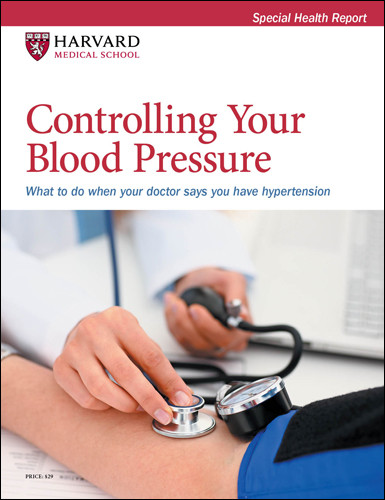Do you have metabolic syndrome?
Many people have this serious condition and don't know it.
- Reviewed by Howard E. LeWine, MD, Chief Medical Editor, Harvard Health Publishing; Editorial Advisory Board Member, Harvard Health Publishing

As you age, you want to pay more attention to your health numbers, including your waist size, blood lipids (cholesterol and triglycerides), blood pressure, and blood sugar levels. You and your doctor may focus on them individually, but they are all very connected in our bodies.
More than a century ago, scientists began to recognize that abnormalities in these health measures appeared to cluster together in some people. In the 1970s, the term “metabolic syndrome” was coined to describe this collection of interrelated conditions. The term evolved into a more formal definition based on meeting at least three of the five following criteria:
- You have abdominal obesity (the accumulation of fat within the belly), defined as a waist size of 40 inches or greater in men (35 inches or more in women).
- Your blood triglyceride level is 150 milligrams per deciliter (mg/dL) or greater, or you’re taking medication to lower triglycerides. A triglyceride level is routinely measured as part of a lipid profile.
- Your blood pressure is 130/85 millimeters of mercury (mm Hg) or higher, or you’re taking medication for high blood pressure.
- Your fasting blood sugar level is 100 mg/dL or higher, you’ve been diagnosed with type 2 diabetes, or you’re taking diabetes medication.
- Your HDL cholesterol is below 40 mg/dL (below 50 mg/dL for women). Low HDL is a marker of increased cardiovascular risk.
These factors interact in a complex web that drives the progression of many chronic diseases. Besides significantly increasing your risk for cardiovascular disease (particularly heart attack and stroke), metabolic syndrome means you are much more likely to develop diabetes, kidney disease, fatty liver disease, and sleep apnea (a condition marked by pauses in breathing during sleep). Studies also have found that metabolic syndrome can double the risk of erectile dysfunction.
“Having just one of these metabolic factors is bad enough, but having multiple ones makes the likelihood of bad health outcomes even greater,” says Dr. Howard LeWine, editor in chief of Harvard Men’s Health Watch. “So, men should take action before any numbers become critical, such as when they gain an extra five to 10 pounds, need a bigger pants waist size, or show rising blood pressure, cholesterol, or sugar levels.”
Fat-finding missionOne of the best (and easiest) ways to gauge visceral fat is to measure your waistline using a tape measure. Place the bottom of the tape at the top of your right hipbone, then pull the tape around at navel level (not the narrowest part of your torso). Do not suck in your gut or pull the tape tight enough to compress the area. While a waist size of 40 inches or higher is a factor of metabolic syndrome, you are still at risk even if your waist is slightly larger than usual. “If your waist has crept up to more than half your height in inches — for instance, a 37-inch waist for a six-foot-tall man — you should try to shrink it,” says Dr. Howard LeWine, editor in chief of Harvard Men’s Health Watch. Even putting on an extra three to five pounds is a potential warning sign. “The more extra weight you carry, the greater the risk for high visceral fat,” says Dr. LeWine. |
A weighty problem
While each metabolic syndrome factor is problematic, the epicenter is abdominal obesity, according to Dr. LeWine. “Excess visceral fat, which surrounds our internal organs and builds up in our liver, is a driver of most of the other components of metabolic syndrome,” he says. “This metabolically active fat is tightly linked to insulin resistance, which leads to higher blood sugar, increased triglyceride levels, and elevated blood pressure.”
When it comes to fat, it’s not just the amount that’s an issue, but where it accumulates. Many people assume that “bad” fat is the kind they can pinch around their waist, called subcutaneous fat. However, this type is less dangerous than visceral fat. While a waist size of 40 inches officially defines one metabolic syndrome criterion, any excess belly fat begins to increase your chance of qualifying for the diagnosis.
Excess visceral fat can trigger a domino effect of health problems that lead to the other metabolic factors and increase the risk of diseases. Here’s how.
- Inflammation. Visceral fat secretes inflammatory molecules. This creates a state of persistent low-grade inflammation, which can damage blood vessel linings and increase the risk of heart attack and stroke. Also, arteries become stiffer, making it harder for blood to flow smoothly and elevating blood pressure.
- Insulin resistance. Excess belly fat is highly associated with insulin resistance, a state in which muscle, fat, and liver tissue cells become less responsive to insulin. Insulin resistance leads to a buildup of sugar in the bloodstream and, over time, can eventually lead to diabetes.
- Liver disease. Excess triglycerides and other fats that get deposited in the liver can lead to metabolic dysfunction–associated steatotic liver disease, or MASLD (previously called nonalcoholic fatty liver disease). In some people, this liver fat promotes inflammation, causing a noninfectious type of hepatitis and potentially cirrhosis (scarring of the liver). People with cirrhosis are at increased risk of liver cancer and liver failure.
Lifestyle changes
Shrinking your waistline to help reduce visceral fat can have the biggest across-the-board impact. “Managing your weight can improve most everything related to metabolic syndrome,” says Dr. LeWine. The best way to reduce excess fat is the standard formula for overall health: weight management, aerobic exercise, strength training, and a plant-based diet. But keep in mind that visceral fat can be slow to come off. “When you put on extra pounds, you tend to add visceral fat before you gain subcutaneous fat,” says Dr. LeWine. “But when you lose weight, the visceral fat is slower to come off.”
Following the plant-based Mediterranean diet or the Dietary Approaches to Stop Hypertension (DASH) diet can help with weight loss as you eat less processed food and more whole fruits, vegetables, grains, and healthy fats. Such a diet can also assist with other metabolic syndrome factors.
For instance, both diets are low in sodium compared to a traditional Western diet; reducing sodium intake is an excellent way to address high blood pressure. And following a plant-based diet has been shown to improve insulin sensitivity. Exercise guidelines recommend at least 150 minutes of moderate-intensity aerobic exercise per week (for instance, 30-minute workouts, five days a week), along with two strength and two balance training sessions each week. This routine helps burn calories and tap into stored visceral fat.
The kind of aerobic exercise doesn’t matter as long as the intensity raises your heart rate enough that it is difficult to hold a conversation. Some of your aerobic workouts might include high-intensity interval training, or HIIT. With HIIT, you exercise at a higher intensity for a brief time, followed by a period at a slower pace to catch your breath. You repeat the cycle for the entire workout. You can enlist a personal trainer to help design a HIIT program and teach you how to perform the exercises correctly and safely.
The role of medication
In addition to diet and exercise some people may also benefit from taking a GLP-1 receptor agonist to help with weight loss. These drugs were initially prescribed to treat diabetes, but in the wake of several studies showing their effectiveness for weight loss, the FDA has approved three in formulations designed to treat obesity: semaglutide (Wegovy), liraglutide (Saxenda), and tirzepatide (Zepbound). GLP-1 medications mimic a hormone (glucagon-like peptide 1) that helps the body slow stomach emptying, control blood sugar levels, and suppress appetite, a combination that leads to weight loss. These drugs come in the form of a self-injection pen that you use daily or weekly.
The drugs are approved only for people diagnosed with obesity (a BMI of 30 or greater) or a high degree of overweight (a BMI of 27 to 29.9), as well as a medical problem related to excess weight, such as high blood pressure or high cholesterol. A potential downside to GLP-1 drugs is that you have to stay on them indefinitely, as you likely will regain the weight if you stop taking them. You should speak with your doctor about whether one of these treatments is an option.
Image: © sakai000/Getty Images
About the Author

Matthew Solan, Executive Editor, Harvard Men's Health Watch
About the Reviewer

Howard E. LeWine, MD, Chief Medical Editor, Harvard Health Publishing; Editorial Advisory Board Member, Harvard Health Publishing
Disclaimer:
As a service to our readers, Harvard Health Publishing provides access to our library of archived content. Please note the date of last review or update on all articles.
No content on this site, regardless of date, should ever be used as a substitute for direct medical advice from your doctor or other qualified clinician.
















